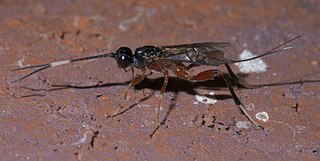
Diplolepis is a genus of approximately fifty species of gall-inducing wasps in the family Diplolepididae. The larvae induce galls on wild roses (Rosa), and rarely on domestic roses.

Rhopalosomatidae is a family of Hymenoptera containing about 68 extant species in four genera that are found worldwide. Three fossil genera are known.

The Braconidae are a family of parasitoid wasps. After the closely related Ichneumonidae, braconids make up the second-largest family in the order Hymenoptera, with about 17,000 recognized species and many thousands more undescribed. One analysis estimated a total between 30,000 and 50,000, and another provided a narrower estimate between 42,000 and 43,000 species.

The Gasteruptiidae are one of the more distinctive families among the apocritan wasps, with surprisingly little variation in appearance for a group that contains around 500 species in two subfamilies and with 6 genera worldwide. They are members of Evanioidea.

Banksia marginata, commonly known as the silver banksia, is a species of tree or woody shrub in the plant genus Banksia found throughout much of southeastern Australia. It ranges from the Eyre Peninsula in South Australia to north of Armidale, New South Wales, and across Tasmania and the islands of Bass Strait. It grows in various habitats, including Eucalyptus forest, scrub, heathland and moorland. Banksia marginata varies widely in habit, ranging from a 20-centimetre (7.9 in) shrub to a 12-metre (40 ft) tree. The narrow leaves are linear and the yellow inflorescences occur from late summer to early winter. The flower spikes fade to brown and then grey and develop woody follicles bearing the winged seeds. Originally described by Antonio José Cavanilles in 1800, further collections of B. marginata were designated as several separate species by Robert Brown in 1810. However, all were reclassified as a single species by George Bentham in 1870. No distinct subspecies have been recognised by Banksia expert Alex George, who nonetheless concedes that further work is needed.

A wasp is any insect of the narrow-waisted suborder Apocrita of the order Hymenoptera which is neither a bee nor an ant; this excludes the broad-waisted sawflies (Symphyta), which look somewhat like wasps, but are in a separate suborder. The wasps do not constitute a clade, a complete natural group with a single ancestor, as bees and ants are deeply nested within the wasps, having evolved from wasp ancestors. Wasps that are members of the clade Aculeata can sting their prey.

Microgastrinae is a subfamily of braconid wasps, encompassing almost 3,000 described species, with an estimated 30,000–50,000 total species. This makes it one of the richest subfamilies with the most species of parasitoid wasps.

The Cheloninae are a cosmopolitan subfamily of braconid parasitoid wasps.

Agathidinae is a subfamily of braconid parasitoid wasps. Some species have been used in biological control programs.

The Doryctinae or doryctine wasps are a large subfamily of parasitoid wasps within the family Braconidae.

Leptocybe invasa, the blue gum chalcid wasp or eucalyptus gall wasp, is a chalcid wasp which is the only species in the monotypic genus Leptocybe in the subfamily Tetrastichinae, of the family Eulophidae. It is a gall wasp which causes the formation of galls on a number of species of Eucalyptus, it was described in 2004 after galls were found in river red gums in the Mediterranean and Middle East and has since been found to be a widespread species where its host trees are planted. It is indigenous to Australia.

Dolichogenidea is a genus of parasitoid wasps in the family Braconidae. There are more than 360 described species in Dolichogenidea, found throughout the world.

Wilkinsonellus is a genus of braconid wasps in the family Braconidae. There are more than 20 described species in Wilkinsonellus, generally found in warmer parts of the globe.

Cynipini is a tribe of gall wasps. These insects induce galls in plants of the beech and oak family, Fagaceae. They are known commonly as the oak gall wasps. It is the largest cynipid tribe, with about 936 to 1000 recognized species, most of which are associated with oaks. The tribe is mainly native to the Holarctic.

Spathius is a genus of doryctine wasps. The larvae of this genus of wasps feed on beetle larvae. They act as biological controllers of the certain pest beetles, such as Hylurgopinus rufipes and the emerald ash borer.
AdeliiniViereck, 1918 is a tribe of braconid parasitoid wasps within the subfamily Cheloninae. Until 2016, Adeliini was classified as a separate subfamily, the Adeliinae. However, the name Adeliini Kirby, 1828 for a tribe of beetles has priority, and Adeliini Viereck, 1918 is a junior homonym.

Brachistinae is a subfamily of braconid wasps in the family Braconidae.

Helconinae is a subfamily of braconid wasps in the family Braconidae.

Phrynixus astutus is a weevil that is endemic to New Zealand. It has been found in lawns and garden beds in private gardens in Dunedin, and in two Wellington sanctuaries, Zealandia and Otari Wilsons Bush. This weevil is known to be a host for the parasitoid wasp Metaspathius kuscheli.

















